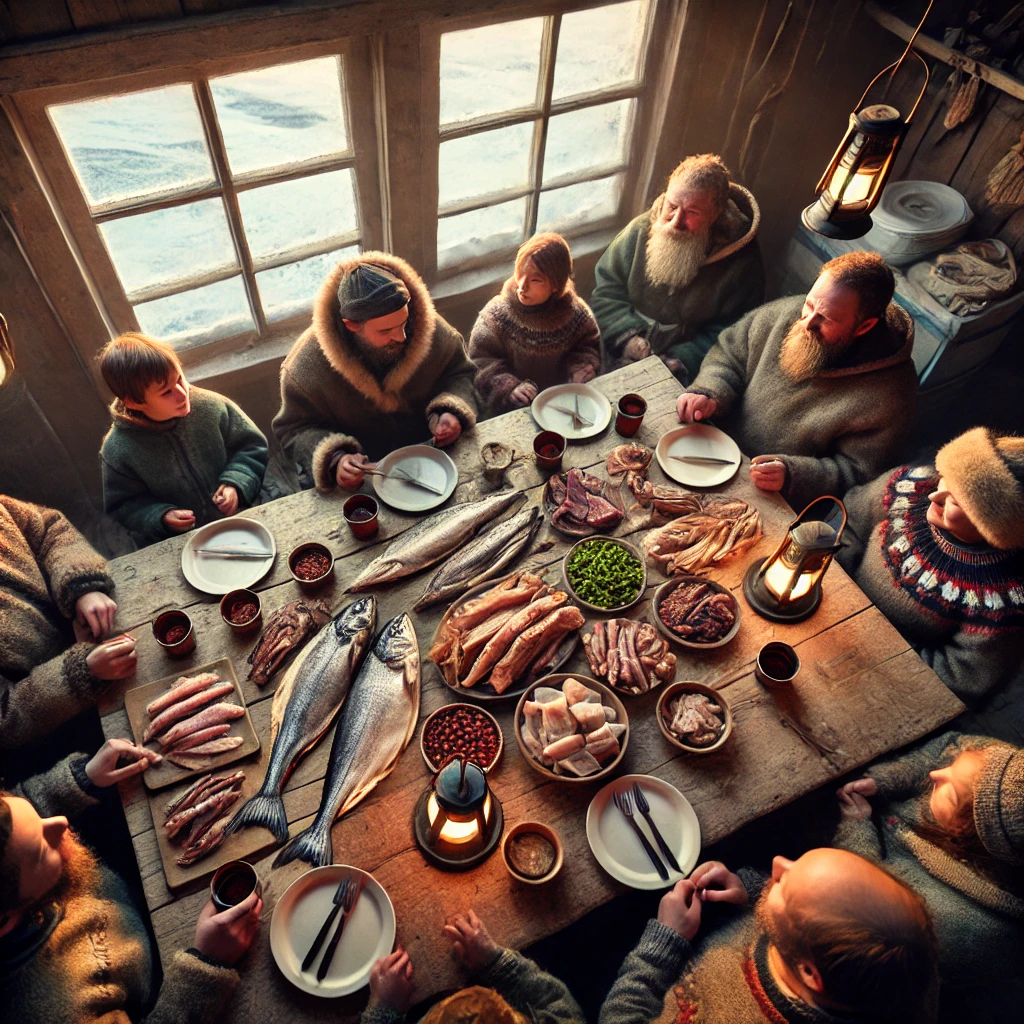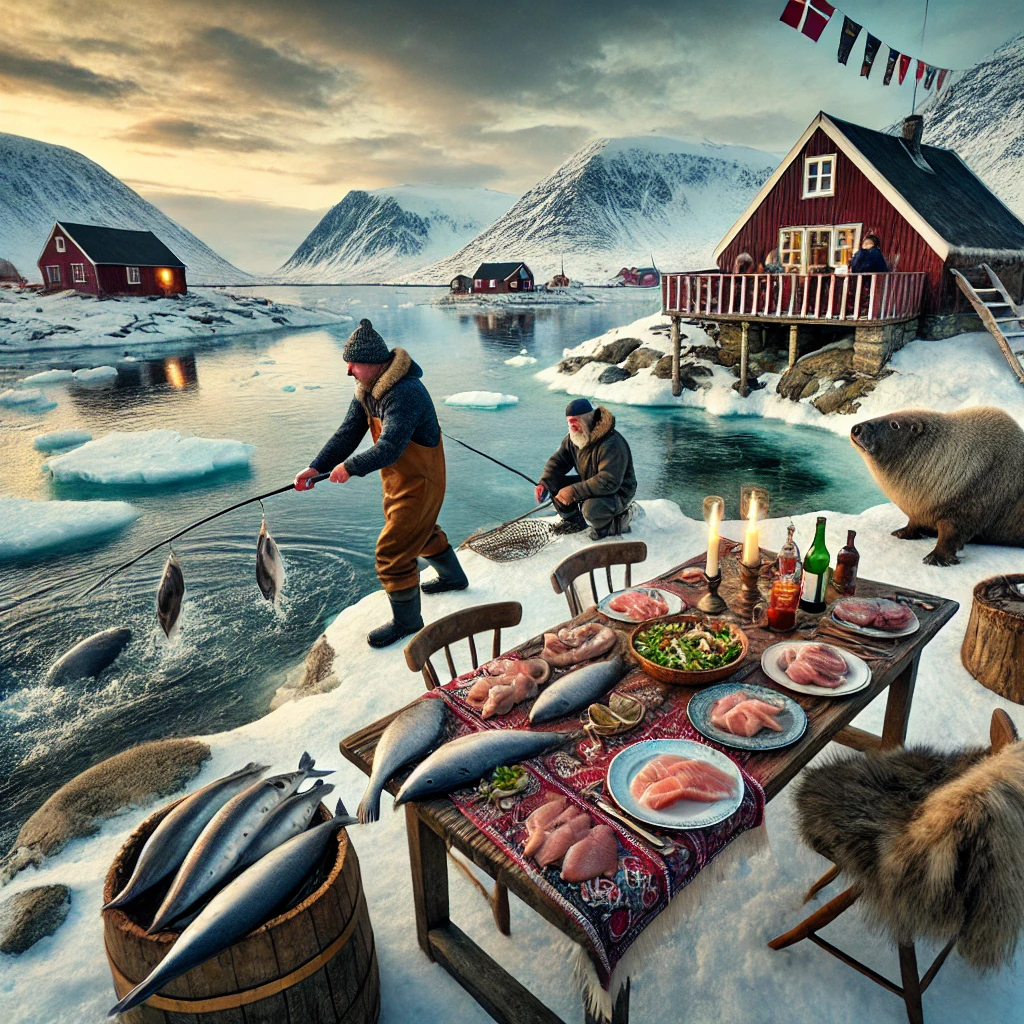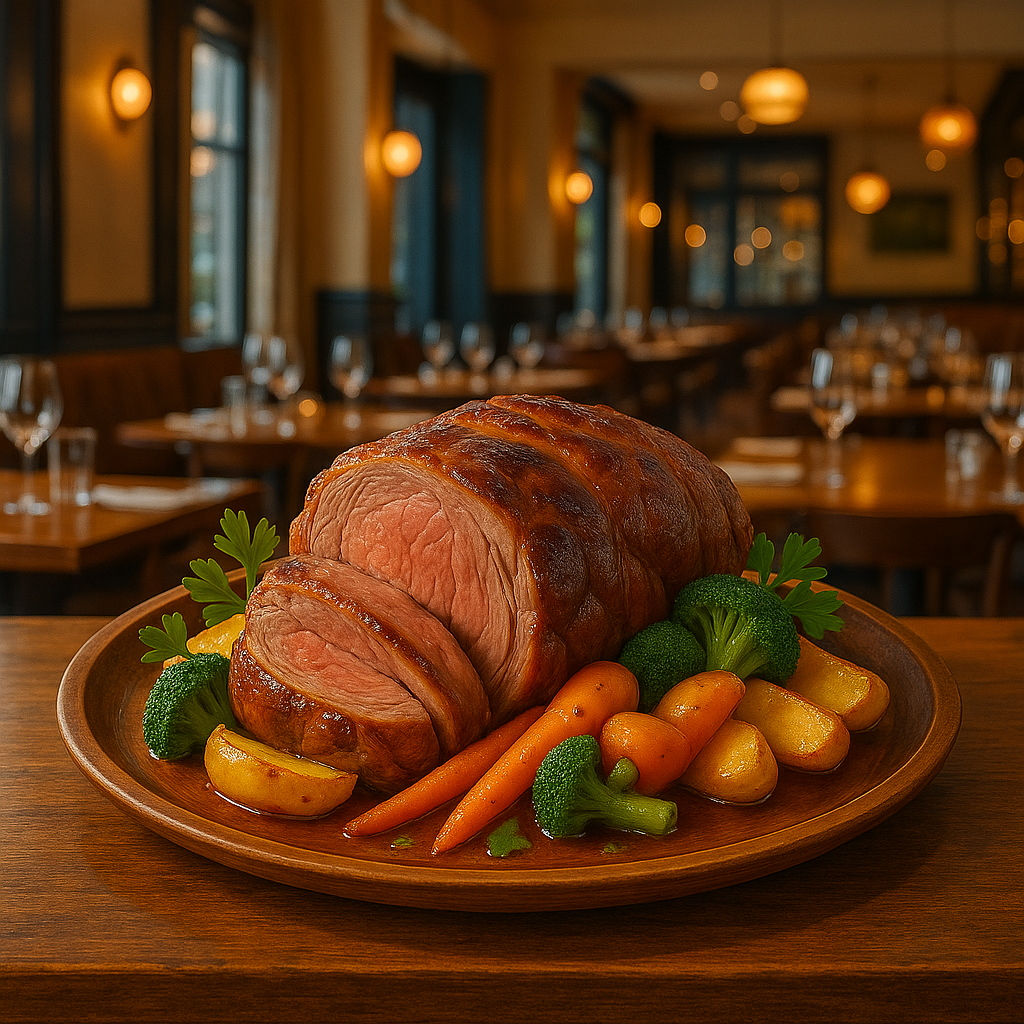Table of Contents
Introduction to Greenlandic Cuisine
Greenlandic cuisine serves as a fascinating reflection of the territory’s unique geography and climate, heavily influencing the food available to its inhabitants. The harsh Arctic environment, characterized by extreme temperatures and limited agricultural possibilities, necessitates a reliance on traditional hunting and fishing practices. As a result, the culinary landscape of Greenland is heavily intertwined with its natural resources, offering a diet that is predominantly based on seafood and game. The cultural significance underlying these practices underscores an enduring relationship between the people and their environment.
Fishing in the cold, nutrient-rich waters surrounding Greenland provides a vital source of sustenance through various species such as cod, halibut, and shrimp. These aquatic resources are harvested using methods passed down through generations, reflecting a rich tradition of expertise and sustainable practices. The fishing industry not only feeds local communities but also contributes significantly to Greenland’s economy. Similarly, hunting plays an equally important role, with caribou, seals, and seabirds forming critical components of the diet. The ability to successfully hunt these animals is integral to survival, especially during the long winters when food availability becomes even more limited.
The interplay between geographic factors and traditional practices is evident in the seasonal availability of different foods. For instance, the summer months bring a bountiful harvest of fish, while the winter is more reliant on preserved game. This cyclical approach to food consumption emphasizes the importance of sustainability and respect for the natural environment. As one delves deeper into Greenlandic cuisine, it becomes clear that fishing and hunting are not merely means of sustenance, but deeply embedded cultural practices that honor the Arctic’s ecology. Understanding this context sets the stage for exploring the specific roles these activities play in contemporary Greenlandic culinary traditions.

Historical Context of Fishing and Hunting in Greenland
The practices of fishing and hunting among the Greenlandic people have deep roots in their history, forming the backbone of their subsistence and culinary traditions. Indigenous methodologies, such as the use of kayaks for hunting seals and harpoons for fishing, were tailored to the harsh Arctic environment, allowing communities to harness the abundant resources of the sea and land effectively. These traditional tools were often crafted from locally sourced materials, reflecting the ingenuity and adaptability of the Greenlandic Arctic inhabitants. Over centuries, such practices became deeply interwoven with their cultural identity and social practices.
With the arrival of European colonizers in the 18th century, significant changes began to occur in Greenlandic hunting and fishing methodologies. The introduction of new technologies, such as rifles and modern fishing gear, revolutionized these activities. While such advancements increased efficiency, they also led to challenges, including over-fishing and the depletion of certain species. Traditional hunting methods faced pressure, as modern influences started to dominate the ways in which communities engaged with the environment.
Furthermore, as globalization progressed, the indigenous ecological knowledge began to encounter alteration from external pressures, such as climate change, which has further impacted marine and terrestrial ecosystems. The reliance on fishing and hunting as central activities within Greenlandic cuisine continues, albeit with the need to balance practices between tradition and modern sustainability. Understanding this historical context allows for a more meaningful appreciation of the present-day culinary landscape in Greenland, where traditional recipes often celebrate the fruits of both historic and contemporary fishing and hunting practices. By recognizing the evolution of these methods, one can better grasp their significance in today’s Greenlandic culture and cuisine.
Traditional Fishing Techniques
Fishing has long been a cornerstone of Greenlandic culture, shaping not only the diet but also the social fabric of the communities. Traditional fishing techniques are diverse and practical, designed to optimize the specific environmental conditions found in Greenland. Among these techniques, net fishing stands out as a widely practiced method, especially for targeting species like halibut and cod. Fishermen cast large, woven nets into the water to catch schools of fish. This technique requires significant skill and experience, as the timing and placement of the nets can greatly influence success rates.
Ice fishing is another traditional practice that reflects the innovative adaptation of Greenlanders to their harsh climatic conditions. During the winter months, when the waters freeze, anglers cut holes into the ice using specialized tools. They often use baited hooks or small jigs to catch fish such as Arctic char and cod. Ice fishing provides not only sustenance but also serves as a communal activity, where families gather to share stories and bond over their shared experiences in the icy wilderness.
Additionally, trap fishing is a method steeped in tradition, where traps or pots are strategically placed in water bodies, allowing fish to enter but making it difficult for them to escape. This technique is particularly effective for species such as shrimp and crab, which play a significant role in the local diet. The cultural significance of fishing extends beyond sustenance; it encompasses various local festivals and community gatherings that celebrate the harvests. These events often feature traditional songs, dances, and storytelling, highlighting the deep connections between the Greenlandic people and their maritime environment. Fishing is not purely a means of food procurement; it represents a lifestyle and a community’s identity, reflecting their heritage and resilience in the face of changing circumstances.
Hunting Practices in Greenland
Hunting plays a pivotal role in Greenlandic culture and cuisine, deeply rooted in the traditions and livelihoods of its indigenous communities. The hunting of marine mammals, such as seals and whales, along with land animals like caribou, has been practiced for centuries, reflecting a symbiotic relationship between the people and their environment. These activities are not merely for sustenance but are woven into the cultural identity of Greenland; they embody a way of life that has been shaped by the harsh Arctic ecosystem.
Traditional hunting practices require a deep knowledge of the natural world and its seasonal rhythms. For instance, seal hunting typically occurs during the periods when the ice conditions are optimal, allowing hunters to access breathing holes or cracks in the ice where seals are known to surface. Similarly, whale hunting is conducted during specific seasons when certain species migrate through the waters off Greenland’s coast. Caribou hunting is coordinated around the animal’s migration patterns, with hunters often utilizing traditional methods such as snares and bows alongside modern equipment.
The tools employed in these hunts reflect a blend of tradition and modernity. Traditional kayaks, known as umiaq, are still used for hunting seals and whales, showcasing the ingenuity and craftsmanship of the Greenlandic people. On land, hunters might utilize rifles or traditional bows when hunting caribou, ensuring efficiency and effectiveness while acknowledging the importance of the hunted species in terms of both food and respect for nature.
Ethical considerations are paramount in Greenlandic hunting practices. Hunters engage in sustainable practices, ensuring that wildlife populations remain healthy for future generations. This is often guided by community regulations and a profound understanding of ecological balance. Accordingly, hunting in Greenland not only serves practical needs but also reinforces a cultural ethos that prioritizes conservation and respect for the land, ultimately sustaining communities and preserving an invaluable cultural legacy.
Role of Fishing and Hunting in Daily Life
Fishing and hunting are integral components of daily life for the inhabitants of Greenland, deeply woven into the cultural, social, and economic fabrics of the community. These activities provide essential sustenance, allowing Greenlanders to rely on traditional food sources that are rich in nutrition and closely tied to the environment. Traditional fishing methods, such as using nets and traps, have been passed down through generations, ensuring that the knowledge and skills required for harvesting local fish species remain alive. Similarly, hunting seals, whales, and migratory birds is not only a means of acquiring food but also reflects the respect for and connection to nature that is central to Greenlandic identity.
In addition to sustaining families, fishing and hunting help shape social structures within communities. These activities foster strong communal bonds, as they are often conducted collectively, with families and friends coming together to share in the experience. This cooperation creates a sense of belonging and mutual reliance among the participants, reinforcing social ties and cultural traditions. The shared practice of fishing and hunting also allows for the transfer of knowledge, where elders teach younger generations essential skills, thereby preserving traditional wisdom.
The modern era has introduced new dynamics to these age-old practices. While traditional methods of fishing and hunting remain prevalent, the accessibility of contemporary resources has led to changes in how these activities are conducted. Motorized boats, modern hunting gear, and updated technology in tracking wildlife have made these practices more efficient, yet they also pose a challenge to traditional methods and ethics. This evolution illustrates the adaptability of Greenlanders as they strive to maintain their cultural heritage while navigating the complexities of modern life.
Key Species in Greenlandic Cuisine
Greenlandic cuisine is deeply intertwined with its natural environment, heavily relying on various species obtained through traditional fishing and hunting methods. Central to this culinary landscape are fish, seals, whales, and game, each contributing unique flavors, nutritional benefits, and cultural heritage to the region’s dishes.
One of the most significant fish species in Greenland is the Arctic cod, also known as gadus morhua. This fish is not only a staple for local diets but also plays a vital role in the ecosystem. It is known for its mild flavor and flaky texture, making it versatile for various cooking methods, including boiling and frying. Traditional dishes such as dried cod, known as ‘klippfisk’, highlight its significance in preserving food for long winters.
Seals are another critical ingredient in Greenlandic cuisine, particularly the ringed seal. This species is valued for its rich blubber content, which is used in numerous dishes, providing essential fatty acids critical for survival in harsh climates. Preparation methods often involve smoking or boiling, with popular dishes including seal meat stews and raw seal slices, traditionally enjoyed with a side of raw fish or mustard.
Whale meat, especially from the minke whale, holds historical importance and continues to be a significant source of nutrients for many Greenlanders. The meat can be cooked or cured, often served with traditional accompaniments such as potatoes or root vegetables. Recipes featuring whale meat, such as “kiviq” (a type of preserved whale), showcase the innovative ways that this ingredient is utilized in local cuisine.
Finally, game, particularly musk ox and reindeer, offers lean meat rich in protein and iron. These species are often roasted or used in stews, reflecting a deep connection to traditional hunting practices. Dishes like musk ox stew exemplify the bold flavors associated with incorporating game into the diet.
Through these key species, Greenlandic cuisine expresses a unique identity that celebrates the region’s abundant natural resources, reflecting both culinary significance and cultural values.
Cultural Significance of Fishing and Hunting
Fishing and hunting hold immense cultural and spiritual significance in Greenland, forming the backbone of traditional practices and community life. For the Greenlandic people, these activities are not merely means of sustenance; they represent a profound connection to the natural world and a deep-rooted heritage that has been passed down through generations. Engaging in fishing and hunting is a way to honor the ancestors, who relied on these practices to thrive in the harsh Arctic environment.
Folklore surrounding fishing and hunting is rich and varied, often featuring tales of supernatural beings and heroic exploits that reflect the values and beliefs of the community. These stories serve to educate younger generations about the importance of respect for nature and the balance of ecosystems. Rituals accompanying hunting trips, such as offerings to the spirits of animals, emphasize the spiritual realm that accompanies these fundamental activities. In this way, fishing and hunting transcend their practical purposes and become synonymous with cultural identity and continuity.
Additionally, community identity is intricately linked to these activities. Fishing and hunting often foster camaraderie, as groups participate together, reinforcing social bonds and collective heritage. However, modern influences have begun to reshape these practices. While traditional methods are still cherished, contemporary technologies and attitudes are incorporated, creating a dynamic relationship between ancient customs and modern life. As Greenlandic society faces global changes—including climate shifts—maintaining the traditions of fishing and hunting becomes essential to preserve not only food security but also the unique cultural identity of the Greenlandic people.
Modern Challenges and Sustainability
Greenland’s fishing and hunting communities face a myriad of contemporary challenges that threaten their traditional practices and local ecosystems. Climate change emerges as a significant concern, altering the marine environment and impacting fish populations essential for sustenance and economic stability. Rising sea temperatures and shifting ice patterns disrupt the seasonal migrations of species like cod, halibut, and shrimp. Consequently, Greenlandic fishermen find it increasingly difficult to locate reliable catches, leading to uncertainty in a profession that relies heavily on seasonal rhythms.
Moreover, overfishing poses a substantial challenge for both commercial and subsistence activities. Increased accessibility to fishing grounds due to melting ice has attracted external fishing interests, exacerbating pressures on already vulnerable fish stocks. This situation emphasizes the necessity for effective management practices to ensure sustainable fisheries that can support both local communities and the environment. Regulatory frameworks are being developed to create limits on catch quotas, which are designed to maintain ecological balance while preserving the traditional fishing practices that have been passed down through generations.
In response to these challenges, various sustainability practices are being embraced within Greenlandic society. Local initiatives focusing on responsible hunting and fishing are being prioritized to mitigate adverse environmental impacts and safeguard biodiversity. Artisans and farmers are increasingly promoting the importance of traditional methods that ensure a minimal ecological footprint. Collaborative efforts between indigenous communities, government bodies, and environmental organizations have created programs aimed at educating the public and encouraging participation in sustainable practices. This integration fosters a balance between meeting modern demands and sustaining the traditions that are integral to the Greenlandic way of life.
Ultimately, while the challenges of climate change and overfishing threaten the fabric of Greenlandic cuisine, a commitment to sustainability and the preservation of traditional lifestyles remains pivotal in navigating these modern trials.
Conclusion: The Future of Greenlandic Cuisine
Greenlandic cuisine, deeply influenced by its rich biodiversity and indigenous practices, continues to underscore the significance of fishing and hunting as foundational elements. The relationship between the inhabitants of Greenland and their environment shapes not only their dietary habits but also their cultural identity. As we have explored throughout this discussion, traditional practices surrounding fishing and hunting are crucial for sustaining both food sources and cultural heritage.
In an age marked by globalization and changing food systems, Greenlandic cuisine faces both challenges and opportunities. The encroachment of modern culinary trends poses a risk to traditional food practices; however, there is a growing awareness and appreciation for sustainable methods rooted in indigenous knowledge. By prioritizing the harvesting of local fish and game, Greenlanders are not only preserving age-old traditions but also promoting ecological balance. This sustainable approach serves as a model for other regions grappling with similar challenges.

Furthermore, the rise of eco-conscious consumers globally provides a promising avenue for the promotion of Greenlandic food products. As the interest in locally sourced, sustainable food grows, there is potential for Greenlandic cuisine to gain increased recognition on the international stage. Supporting local hunters and fishermen not only strengthens community ties but also contributes to the preservation of culturally significant practices. By embracing the inherent value of traditional cuisine, there is hope for a future where Greenlandic culinary practices are not only sustained but celebrated. Thus, fostering an appreciation for these practices is essential as we move forward, ensuring that future generations remain connected to their cultural roots while navigating the complexities of modernity.





